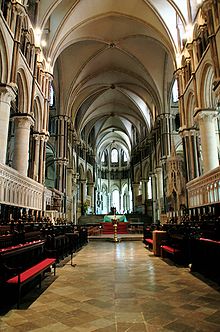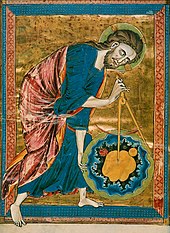Renaissance of the 12th century

The Renaissance of the 12th century was a period of many changes at the outset of the High Middle Ages. It included social, political and economic transformations, and an intellectual revitalization of Western Europe with strong philosophical and scientific roots. For some historians these changes paved the way to later achievements such as the literary and artistic movement of the Italian Renaissance in the 15th century and the scientific developments of the 17th century.
Contents[hide] |
[edit] Historiography
Charles H. Haskins was the first historian to write extensively about a renaissance that ushered in the High Middle Ages starting about 1070. In 1927, he wrote that:
[the 12th century in Europe] was in many respects an age of fresh and vigorous life. The epoch of the Crusades, of the rise of towns, and of the earliest bureaucratic states of the West, it saw the culmination of Romanesque art and the beginnings of Gothic; the emergence of the vernacular literatures; the revival of the Latin classics and of Latin poetry and Roman law; the recovery of Greek science, with its Arabic additions, and of much of Greek philosophy; and the origin of the first European universities. The twelfth century left its signature on higher education, on the scholastic philosophy, on European systems of law, on architecture and sculpture, on the liturgical drama, on Latin and vernacular poetry...[1]
[edit] Translation movement
The translation of texts from other cultures, especially ancient Greek works, was an important aspect of both this Twelfth-Century Renaissance and the latter Renaissance (of the 15th century). The relevant difference being that Latin scholars of this earlier period focused almost entirely on translating and studying Greek and Arabic works of natural science, philosophy and mathematics, while the latter Renaissance focus was on literary and historical texts.
[edit] Trade and commerce
In Northern Europe, the Hanseatic League was founded in the 12th century, with the foundation of the city of Lübeck in 1158–1159. Many northern cities of the Holy Roman Empire became Hanseatic cities, including Hamburg, Stettin, Bremen and Rostock. Hanseatic cities outside the Holy Roman Empire were, for instance, Bruges, London and the Polish city of Danzig (Gdańsk). In Bergen and Novgorod the league had factories and middlemen. In this period the Germans started colonizing Eastern Europe beyond the Empire, into Prussia and Silesia.
In the late 13th century, a Venetian explorer named Marco Polo became one of the first Europeans to travel the Silk Road to China. Westerners became more aware of the Far East when Polo documented his travels in Il Milione. He was followed by numerous Christian missionaries to the East, such as William of Rubruck, Giovanni da Pian del Carpini, Andrew of Longjumeau, Odoric of Pordenone, Giovanni de Marignolli, Giovanni di Monte Corvino, and other travelers such as Niccolò da Conti.
[edit] Science
After the collapse of the Western Roman Empire, Western Europe had entered the Middle Ages with great difficulties. Apart from depopulation and other factors, most classical scientific treatises of classical antiquity, written in Greek, had became unavailable. Philosophical and scientific teaching of the Early Middle Ages was based upon the few Latin translations and commentaries on ancient Greek scientific and philosophical texts that remained in the Latin West.
This scenario changed during the renaissance of the 12th century. The increased contact with the Islamic world in Spain and Sicily, the Crusades, the Reconquista, as well as increased contact with Byzantium, allowed Europeans to seek and translate the works of Hellenic and Islamic philosophers and scientists, especially the works of Aristotle.
The development of medieval universities allowed them to aid materially in the translation and propagation of these texts and started a new infrastructure which was needed for scientific communities. In fact, European university put many of these texts at the center of its curriculum,[3] with the result that the "medieval university laid far greater emphasis on science than does its modern counterpart and descendent."[4]
At the beginning of the 13th century there were reasonably accurate Latin translations of the main ancient Greek scientific works. From then on, these texts were studied and elaborated, leading to new insights into the phenomena of the universe.
[edit] Technology
During the High Middle Ages in Europe, there was a change in the rate of new inventions and innovations in the ways of managing traditional means of production and economic growth.
Alfred Crosby described some of this technological revolution in The Measure of Reality : Quantification in Western Europe, 1250-1600 and other major historians of technology have also noted it.
- The earliest written record of a windmill is from Yorkshire, England, dated 1185.
- Paper manufacture began in Spain around 1100, and from there it spread to France and Italy during the 12th century.
- The spinning wheel was brought to Europe (probably from India) in the 13th century.
- The magnetic compass aided navigation, first reaching Europe some time in the late 12th century.
- Eyeglasses were invented in Italy in the late 1280s.
- The astrolabe returned to Europe via Islamic Spain.
- Leonardo of Pisa introduces Hindu-Arabic numerals to Europe with his book Liber Abaci in 1202.
- The West's oldest known depiction of a stern-mounted rudder can be found on church carvings dating to around 1180.
[edit] Scholasticism
A new method of learning called scholasticism developed in the late 12th century from the rediscovery of the works of Aristotle; the works of medieval Jewish and Muslim philosophers influenced by him, notably Maimonides, Avicenna (see Avicennism) and Averroes (see Averroism); and the Christian philosophers influenced by them, most notably Albertus Magnus, Bonaventure and Abélard. Those who practiced the scholastic method believed in empiricism and supporting Roman Catholic doctrines through secular study, reason, and logic. The most famous of the scholastic practitioners was Thomas Aquinas (later declared a "Doctor of the Church"), who led the move away from the Platonic and Augustinian and toward Aristotelianism. Using the scholastic method, Aquinas developed a philosophy of mind by writing that the mind was at birth a tabula rasa ("blank slate") that was given the ability to think and recognize forms or ideas through a divine spark. Other notable scholastics included Roscelin, Peter Abelard, and Peter Lombard. one of the main questions during this time was the problem of the universals. Prominent non-scholastics of the time included Anselm of Canterbury, Peter Damian, Bernard of Clairvaux, and the Victorines.[1]
[edit] Arts
'연구하는 인생 > Histrory' 카테고리의 다른 글
| Renaissance (0) | 2011.04.18 |
|---|---|
| 샤를마뉴(Charlemagne) (0) | 2011.04.18 |
| MEDIEVAL HISTORY (0) | 2011.04.17 |
| The Medieval Castle (0) | 2011.04.17 |
| 십자군 (0) | 2011.04.16 |

